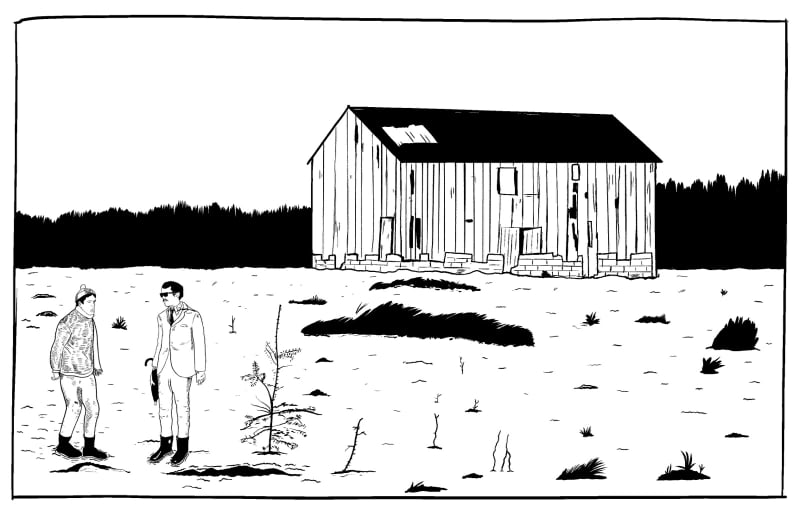
“I can observe my own body cut open, without suffering!… I see myself all the way down to my entrails; a new mirror stage… I can see to the heart of my lover; his splendid design has nothing to do with sickly sentimentalities… Darling, I love your spleen; I love your liver; I adore your pancreas, and the line of your femur excites me.”
–(from Orlan’s Carnal Art manifesto)
Fresh off the heels of selling his own kidney stones in a 24-hour auction, David Cronenberg teased fans with a tantalising soundbite regarding his upcoming film, Crimes of the Future:
“I cannot say much, obviously, but if people thought Crash was divisive back in 1996, this is going to create way more chaos and controversy for sure.”
The 2022 Crimes of the Future appears to be closer in subject matter to an old script by Cronenberg called, Painkillers than the 1970 arthouse film of the same name. In the original Painkillers script Cronenberg explores the world of performance art and was meant to be featuring Spider star, Ralph Fiennes and Nicholas Cage in the title roles. The film is apparently heavily inspired by French ‘carnal artist’, Orlan, who infamously used her own body as a canvas, undergoing nine plastic surgery sessions to bring her vision to life. Revisiting Crimes of the Future seems more like a recalibration of source material than a remake; like an author adding footnotes to a preferred edition of a novel from the juvenile phase of their career. According to Production Weekly, Painkillers, focused on as a radical performance artist who must utilise his high pain threshold to capture a subversive group – with this in mind it seems like there might also be shades of Cronenberg’s Secret Weapons (a 1972 episode from Programme X) thrown into the mix.
With Cronenberg returning to the setting (or title at least) of his second 1970 feature-length film–and the promise of controversy–there is an air of unfinished business surrounding the director and his latest project.
There is a similar element of unfinished business about Stephen Bissette’s relationship with the work of David Cronenberg. Bissette is a legend of underground comics, but he is also a highly regarded member of the celluloid intelligentsia, whose epic critical analysis of The Brood is an integral feature of any Cronenberg completist’s reference library. Earlier this year I invited Stephen to contribute to the anthology I was editing with David Leo Rice, Children of the New Flesh: the early work and pervasive influence of David Cronenberg. I knew that when I tasked Stephen with the spelunking of Cronenberg’s long-forgotten debut short film, Transfer, he would emerge with more than a few minor geodes.
Shot on 16mm in 1966, Transfer is the film that started it all. It’s a simple piece which focuses on two men – a neurotic and his therapist.
With Transfer the Beckett influence seems particularly on the nail, but how important do you think the politique in the early 1960s was to Cronenberg’s early impetus – specifically that of the politique des auteurs, pioneered by French writers-turned-directors like Truffaut, Claude Chabrol and Jean-Luc Godard. Cronenberg certainly seems to fit the profile of an artist-intellectual, someone who perceived themselves as having true creative authority and who would put the success and well-being of their own artistic temperaments above all else.
First off, I’ll note that in my essay, I deliberately avoided noting any similarities between Transfer and the 1962 Elaine May/Mike Nichols sketch about a somewhat dysfunctional doctor/patient psychiatric relationship (see, or rather listen to, the Mercury LP Mike Nichols & Elaine May Examine Doctors, “Merry Christmas, Doctor,” online at https://www.youtube.com/watch?v=pYkN3M31jWM ). If you give that sketch a listen, you’ll note Cronenberg didn’t emulate any substantial aspect of that sketch, lending credence to his stating in interviews he’d never heard the Nichols/May sketch, that it had nothing to do with Transfer.
That review came from a pretty prestigious critic in Urjo Kareda, who worked for the Toronto Globe and Mail. Kareda also dismissed the film as “a pathetic effort… Horribly acted and scarcely directed…”. Pretty scathing.
I take Cronenberg at his word, but he has also stated he took some grief for that at the time. Folks assumed he had to have been ripping on the Nichols/May routine. Whatever initial audience Transfer reached when it was new, some of that audience dismissed Transfer as merely imitative of “Merry Christmas, Doctor,” which had to have stung. An early draft where I engaged with the issue proved unproductive, so I chose to simply engage with Transfer in the terms Cronenberg himself speaks of in interviews, contextualizing his decision to make his first films in the context of his sensibilities and influences as Cronenberg himself remembers and describes them. Thus, the connections with the films and filmmakers Cronenberg cites: the films he was experiencing, the films that interested and excited him, culminating in his first filmmaking efforts.
And the New Wavers?
You specifically note the French wave—Truffaut, Claude Chabrol and Jean-Luc Godard—and their work was unavoidably part of what college campuses and art theatres were exhibiting at the very point in the 1960s where Cronenberg talks about awakening to cinema. In ways that made cinema important enough to him to begin making his own films. While I see your point, Chris, regarding “the profile of an artist-intellectual” a natural fit to Cronenberg’s path, I don’t see much of any of those three filmmakers works reflected in Cronenberg’s early films. There’s none of the warmth, life, or autobiographical naturalism of François Truffaut, and nothing of Chabrol or Godard manifest in Cronenberg’s early works, either. In spirit, as in, “we make what moves us,” sure, I see the correlation, but in practice—just looking at Cronenberg’s films, taking them on their own terms—I don’t see direct correlations. What I do see (as I do, in very different ways, in the first films by John Waters) is the connection with experimental, underground, and avant-garde cinema of the late 1950s and early-to-mid 1960s, from Maya Deren and Kenneth Anger on through to Harrington, Brakhage, Menken, the Andy Warhol/Paul Morrissey films, and so on. Waters talks about traveling to New York City to experience those seminal works; Cronenberg talks about seeing them as part of the growing film culture he felt very much a part of in Toronto in the 1960s.
Do you see anything else in there? Maybe something more populist?
As I note in writing about Transfer, there seem to be elements of Ingmar Bergman’s then-new Persona there, but the time frames don’t align: as best I can tell, Persona didn’t play in Canada until after Cronenberg had completed and exhibited Transfer. That’s what I love about Cronenberg’s first films, though. There isn’t really any manifest cause-and-effect, they still seem fresh and out-of-left-field. I can mount a weak case for possible precursors in Roman Polanski’s short films, but what of it? Cronenberg never, ever mentions seeing those films, Polanski’s short films weren’t (as far as I can tell) ever playing the college or the art house circuits in the mid-1960s, and any similarities are so superficial as to be meaningless. It’s self-evident Cronenberg’s films were wholly his own, from the very beginning.
Be honest, when I asked you to write about Transfer were you a little disappointed I didn’t offer you something meatier from his earlier catalogue?
OK, that’s funny! Well, no—I mean, first of all, I was late to the party, so to speak. The party favours had all been distributed. We only contacted one another after the book was about done, yes? And truth to be told, I was happy to be asked to write about one of the Cronenberg films that has been given precious little attention, and which evidently was about to once again be given precious little attention. The fact I’d edited my own meditation on Transfer out of my own Midnight Movie Monograph on The Brood speaks volumes. It also meant, when you asked, that I just happened to have an already-orphaned text ready to work with. So, no, I wasn’t disappointed. I was, honestly, relieved, since it meant I could finally excavate and complete that unpublished excerpt from my book on The Brood. The excised orphan text had a home at last! Sometimes, these things work out, as if they’re meant to be.
It must be kismet! In the end you wrote a beautiful piece on that movie, but what makes Transfer so interesting to you? It’s clear that when you sank your toes into the soil you wound up finding value in the experience.
Hopefully, my contribution to your book speaks for itself, articulating precisely what makes Transfer so interesting to me. I can only add there is an aspect of Transfer I don’t mention in my essay that lends it an associative importance, for me, personally: having made my own short 8mm and Super 8 films in junior high and high school where I was growing up in northern Vermont, there’s something very familiar, almost cozily familiar, about Transfer. I relate on a primal level to not just the film, but the self-evident aspects of Cronenberg making that film.
Were your own short films similarly experimental? Come on, tell us about Steve Bissette the burgeoning guerrilla filmmaker.
When I was making films (and working with high school friends like Bill Hunter making films as teenagers in Vermont) we faced very similar circumstances: limited resources, limited access to local environments (shooting in remote locations outdoors was always easiest, since you didn’t have to ask for access or permission), limited ideas, limited tech, limited casts (who would actually show up to be part of a film was a constant headache). The semi-barren winter landscape, the abandoned barn, the placing of props in a field to create some semblance of a living space for his two characters, and the one-act-play-like writing and dialogue, it all feels very, very familiar to me.
Sounds like a case of ‘great minds’…
We never came close to making anything remotely like, or as good as, Transfer, mind you! And lucky Cronenberg, he had synchronized sound! We only had silent 8mm and, later, Super 8. So, in short, I respond to Transfer on a gut level: I recognize instantly the ambitions and trappings of a neophyte filmmaker doing all he could with what he had in reach. I’d worn those boots, so to speak (my path led to comics instead of cinema: all I needed was a piece of paper, something to make marks with, and my own imagination and skillset, all of which involved far less collaborative issues, real costs, or technical obstacles than what was available to a Vermont teenager in the late 1960s who ached to tell stories and was making movies in his head).
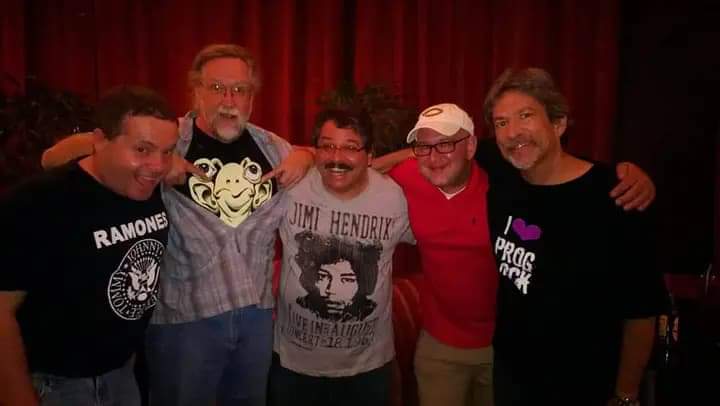
Like your good friend and fellow Children of the New Flesh contributor, Graham Rae, you’re something of a movie anorak. Cronenberg had been stirred into action by his university classmate David Secter, who had directed a feature film called Winter Kept Us Warm, the first English-language Canadian film screened at the Cannes Film Festival – was that a film you became familiar with at all? What are your art-house influences?
Yep, an anorak, that’s me: “a person who is extremely enthusiastic about and interested in something that other people find boring…” Graham is the same. When I was still living in southern Vermont, and the Brattleboro Museum & Art Center partnered with the downtown Latchis Theatre to connect the museum’s Andy Warhol art exhibition with a retrospective of some of the 16mm films Warhol had made or was credited with (Paul Morrissey’s first works with/for Warhol), I was one of three people who continued to show up for those late-night once-a-week showings. It was to the point where the ticket-seller and projectionist sighed when I showed up: shit, they’d have to show the fucking movies, now. There was one show where it was just me and one another person and a decidedly unhappy projectionist. I wasn’t going to skip one of them, this was the only chance I’d ever had to see some of those films, and I wasn’t going to miss out. Yep, a movie anorak, that’s me!
But you were switched on to Canadian cinema, weren’t you?
I’d grown up with access to three Canadian TV stations: English-language Channel 12 out of Montreal, Channel 6 out of Ontario, and the French-language Quebec station Channel 10. I’d grown up watching Canadian TV, including the British programming (Doctor Who, first exposure to Monty Python’s Flying Circus long before it was on American stations), import shows like Ultraman (which I loved), and a lot of Canadian series, including ones my Canadian friends mock me about (the first few years of The Beachcombers, but a childhood favourite The Littlest Hobo—the first series incarnation—is still a favourite of mine). Though I don’t speak or read French, my mother did, so we’d watch Channel 10 now and again and I got very comfortable with watching French movies without understanding the dialogue. It’s how I first experienced Cocteau’s 1946 Le Belle et la Bête, how I stumbled upon an uncut late-night broadcast of Franju’s Les Yeux Sans Visage (after having seen the cut US version Horror Chamber of Dr. Faustus on one of our local American stations), and how I saw the absolutely horrifying La Petite Aurore: l’enfant Martyre more than once. I also used to catch as many of the Canadian anthology programming that I could, including a CBC production of Dracula I have fond memories of – and one half-hour horror tale I’ve never been able to trace, involving a fisherman or hunter, a female Mer-being, culminating in the fisherman gutting a fish he’d caught revealing the Mer-women appearing before him gutted like the fish (when I first read about Cronenberg’s TV work, I couldn’t believe it wasn’t a Cronenberg offering, but it wasn’t). I’ve written about this background, my growing up with Canadian TV and movies, in my introduction to Jean-Marc and Randy Lofficier’s 2000 book French Science Fiction, Fantasy, Horror & Pulp Fiction, and in my Midnight Movie Monograph David Cronenberg’s The Brood. Once I had my driver’s license at age 16, I began making pilgrimages up to Montreal whenever I was able, often just to see movies that weren’t available to see in our neck of the woods, including films like Leone’s Once Upon a Time in the West as well as Canadian films like Why Shoot the Teacher? and The Rowdyman.
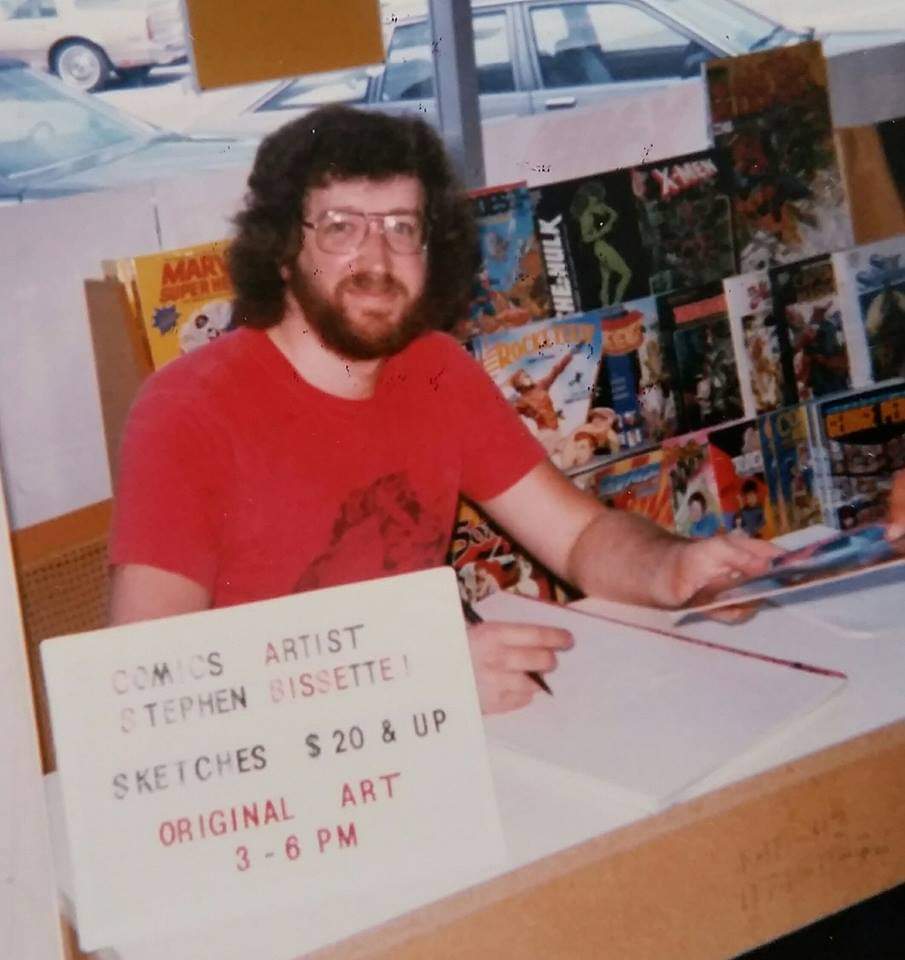
It’s very refreshing to hear an American taking such an avid interest in the cinema of Canada.
See, I was an early subscriber to Take One magazine, published in Canada. I even had a letter published in one issue (corrections to their article on the chronology of the Toho Godzilla films), and I’ve kept and still own a near-complete set. So, yes, as a Take One reader since about the fifth issue of that magazine, I pieced together a ramshackle working knowledge of Canadian cinema history at a time when there were no books on the subject, there was no internet. So, I’d read references to Winter Kept Us Warm, and David Secter, but unlike films like Goin’ Down the Road (which I did manage to catch), I never had the chance to see the film until more recently, on a DVD-R release via TLA Video (whose titles we used to carry at First Run Video, a southern Vermont video superstore I worked at and co-managed). Once it was in reach, I jumped at the chance to see it.
And what about Winter Kept Us Warm?
I don’t recall Winter Kept Us Warm popping up on Canadian television, not the way films like The Rowdyman did; then again, once I went to college in 1974, my access to television was a thing of the past for about two decades. Secter’s film certainly never showed at local Vermont theatres or drive-ins, where I did get to see some of the Cinépix features (including the 1971 partially-shot-in-Vermont Loving and Laughing, which actually opened at a St. Albans theatre, much to the embarrassment of some folks at the time) and Québécois mainstream fare like The Pyx, but a film like Winter Kept Us Warm never was accessible the way the Ilsa films were, or even Dr. Frankenstein on Campus, as well as all of Cronenberg’s horror films. Those all played our drive-ins and sometimes you’d catch them in a neighborhood theatre; my introduction to Cronenberg was catching Rabid at the downtown Dover, NJ theater The Baker when I was a student at the Joe Kubert School of Cartoon & Graphic Art. Later in the 1970s, breakthrough Canadian films like Richard Benner’s Outrageous! became staples at the art houses in New England, I recall seeing that more than once with friends. Having finally seen Winter Kept Us Warm, I totally understand how and why it spoke so urgently to Cronenberg when it was new, how it fuelled his own desire to make his own films, as well as how Winter Kept Us Warm led to later, more successful gay films like Outrageous! which really did get a lot of play here in the states at the time, though its star Craig Russell and the film itself is sadly overlooked and forgotten today.
As for me, my “art house influences,” I was very fortunate to be growing up in northern Vermont in the late 1960s and early 1970s. While we didn’t have any “art house” cinemas per se, my proximity to the University of Vermont in Burlington, VT and Goddard College in Plainfield, VT provided surprising access to all kinds of foreign films, underground films, and alternative cinema by the time I had my driver’s license in 1971. UVM had the Lane Series, live theatre and film retrospectives, and that’s how I got to see their big screen retrospectives of Alfred Hitchcock and Ingmar Bergman, in conjunction with United Artists opening films like Bergman’s The Passion of Anna in a local cinema. UVM also had instructors like Frank Manchel, who taught night classes on film. My pal Bill Hunter and I took one of Manchel’s classes, which afforded us permission to screen Manchel’s 16mm film collection in the basement of the Ira Allen Chapel: two projectors, you’d sign up to screen a film, and Manchel had a pretty comprehensive selection of German silent films, so we crash-coursed on Fritz Lang and the like. Manchel also curated for the Lane Series a retrospective of horror films, which is how I first saw King Kong, Bride of Frankenstein, Freaks, and Les Diaboliques. As luck would have it, the first public television station in Burlington also broadcast a PBS-sponsored series broadcasting foreign films called Film Odyssey, so that’s how I first saw Kurosawa’s The Seven Samurai and Yojimbo, Truffaut’s The 400 Blows, etc. (see the listing at https://letterboxd.com/drfreex/list/pbs-film-odyssey/ and I don’t think I missed a single one).
Were their societies or communities devoted to art house cinema where discerning young cinéastes like you could frequent?
There was not one, but two, competing underground film societies in Burlington for two years or so, meaning not long after I’d devoured Jonas Mekas and Sheldon Renan’s books, I suddenly had opportunities to see some of the underground and earlier avant-garde and experimental films they wrote about. Stan Brakhage himself showed up at Goddard College, showing his films, reading aloud from Ezra Pound, and concluding the evening with a showing of The Act of Seeing With One’s Own Eyes. We had competing 16mm film societies as well, all in driving distance: the Lightning Ridge showings in Montpelier, VT, which Rick Winston and his partner curated, eventually opening the Savoy Theatre in downtown Montpelier in later years; another 16mm film society in Waitsfield, VT, which is how and where I first saw Marcel Carné (Bizarre, Bizarre), Cocteau’s Orpheus, and more. We also had the first theatre with a bar I’d ever seen just ten miles away, part of the Jack Straw Inn in Stowe, VT, where my high school pals Bill Hunter and Alan Finn and I lucked into a showing of Greaser’s Palace when it was new. As far as I know, that was the only time that film every showed nearby us.
The competition between downtown movie theatres in Burlington also meant some very unusual bookings between the Flynn and the long-gone-now Strong Theatre and the State Theatre. That’s how I first experienced Ken Russell’s films, at the Strong, while the State booked really unusual fare now and again. The Strong got into feeding the UVM and college crowd, so a lot of what became in more urban areas midnight and cult movies would pop up in their programming: Harold and Maude, Where’s Poppa?, The Discreet Charm of the Bourgeoisie, King of Hearts, The Ruling Class, The Devils, and most important of all to me, Performance, which I caught two nights in a row because I couldn’t fucking believe what I’d just seen. Looking back, it’s crazy what showed up there, what a time it was. Now and again, I’d brave trips to Boston—that was a haul—to see films that just didn’t play in Vermont; a memorable Orson Welles Cinema double-bill of Sturges’ The Magnificent Seven and Jodorowsky’s El Topo remains a high point in my Boston memories.
Once I moved to Dover, NJ to attend the Kubert School, I was just a bus ride away from New York City, so I binged whenever I could afford the money or time on whatever films I could manage to catch. Between the Deuce and the Village, it was a massive and remarkable cinema diet for about three years, including first-time experiences with Romero’s Martin, Lynch’s Eraserhead.
Finally, my addiction to cinema was such that by junior high school, I jockeyed my way onto the student council, which had student funds earmarked for showing films. I plunged into those 16mm rental catalogues and, within the parameters of what was permitted at our high school, showed a lot of feature films as public showings the locals would come to. We had a sizeable new auditorium, and it wasn’t too shabby a set-up. By the time I attended Johnson State College between the fall of 1974 and summer of 1976, I’d become pretty experienced with 16mm rentals and could be far, far more adventurous in what I booked for the JSC campus. I’ve attached my sketchbook/diary list from the JSC years so you can get a taste of what eclectic cinematic delights I was foisting upon my fellow JSC students. Sergio Leone, Nicolas Roeg, Mario Bava retrospectives along with as many other films as I could book within the student film budget; I’d discovered that Dibden Theater had a set of anamorphic lenses for its projectors, so booking and showing genuine widescreen films fuelled the selections.
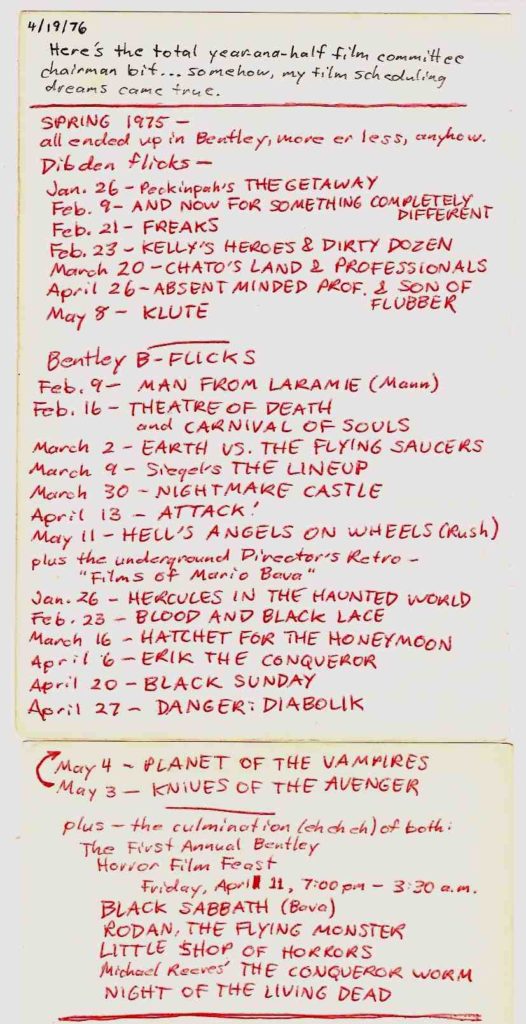
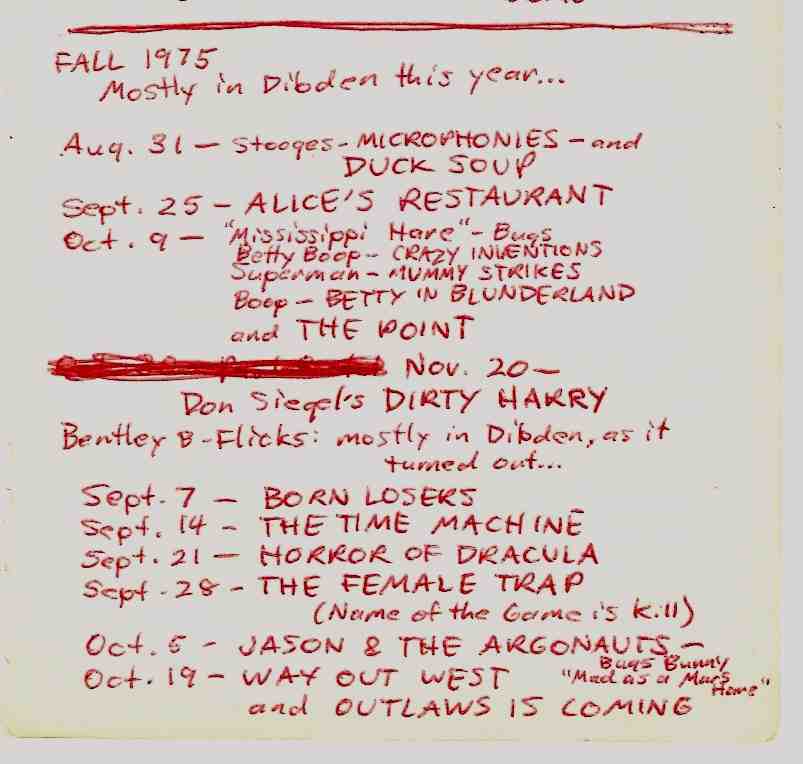
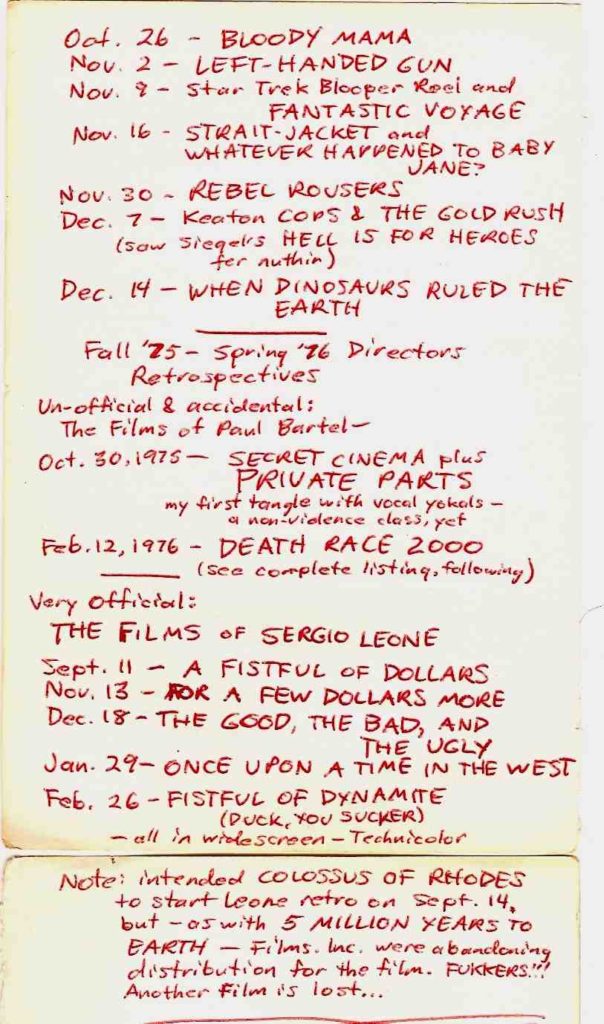
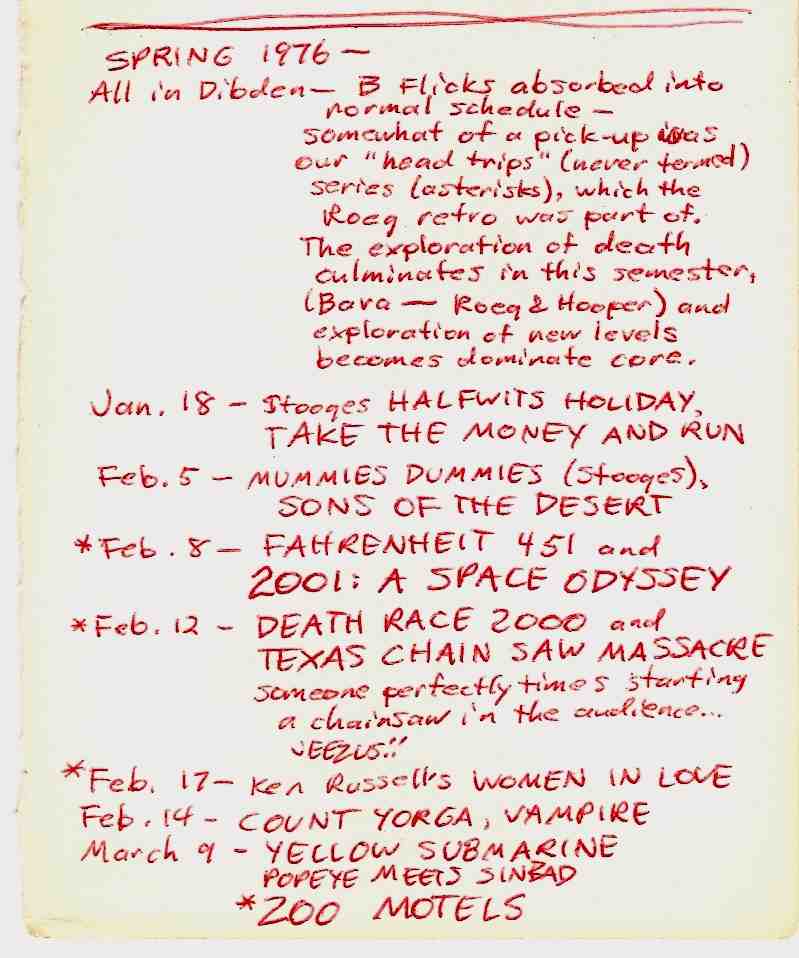
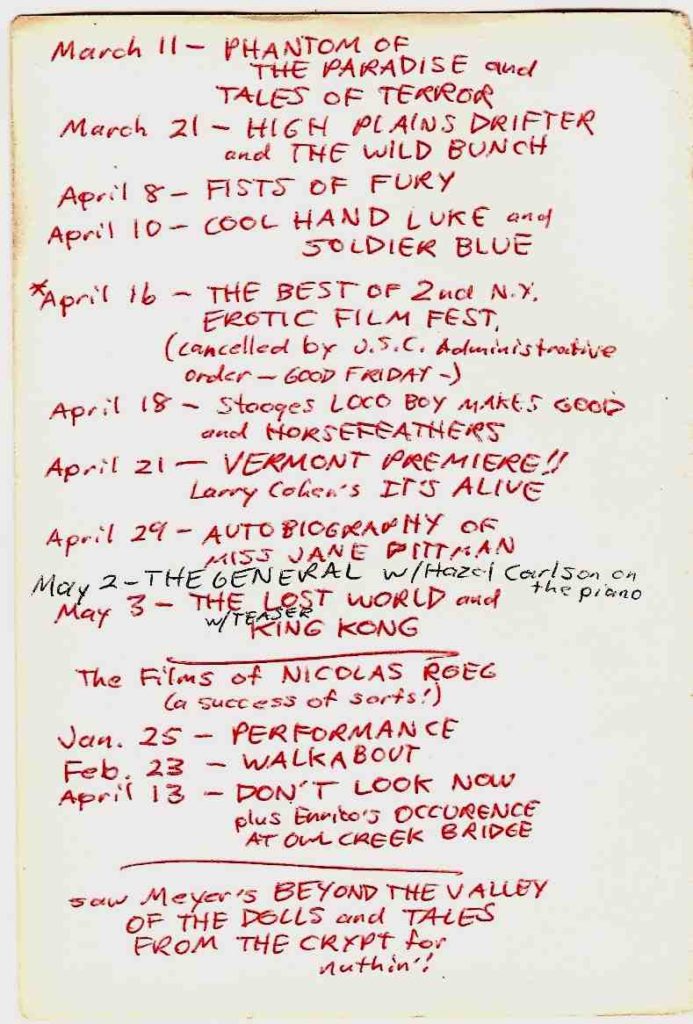
Follow Vol. 1 Brooklyn on Twitter, Facebook, and sign up for our mailing list.
